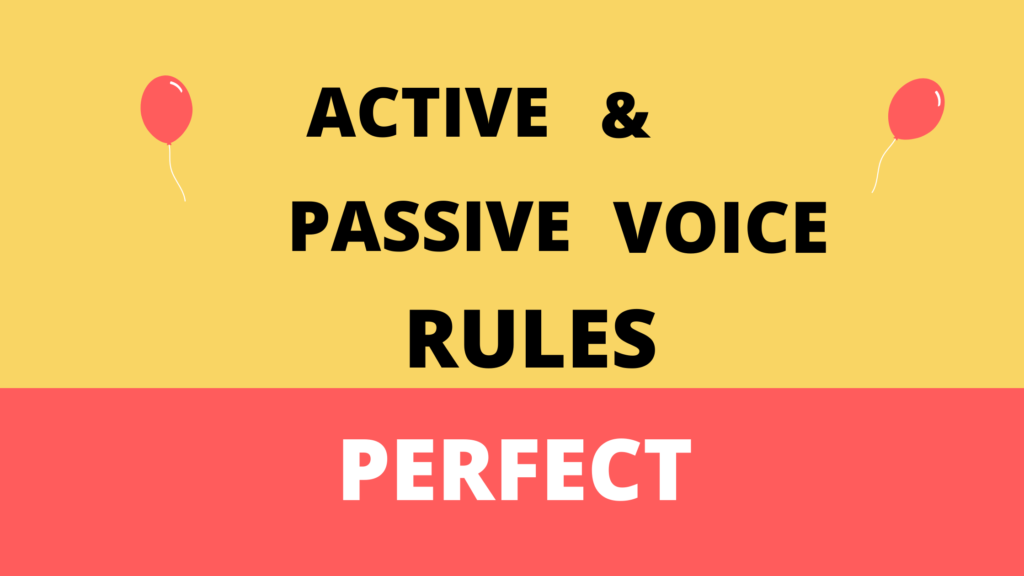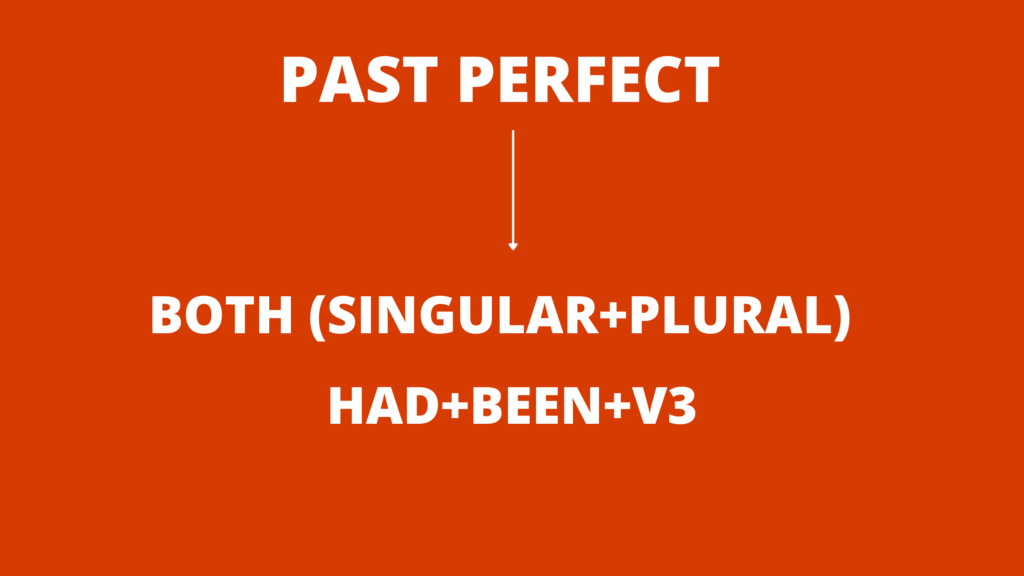
ACTIVE and PASSIVE VOICE RULES (PERFECT) PART-3

INTRODUCTION
Firstly, before going further, learn passive and active voice part -1. Furthermore, This blog is about ACTIVE and PASSIVE VOICE RULES (PERFECT) In addition to this, The concept of VOICE in English is a method that we use to refer to time -PAST, PRESENT, and FUTURE.
In general, the active voice makes your writing stronger, more direct, and, more active. However, The subject is something, or it does the action of the verb in the sentence. In addition to this, in the passive voice, the subject is acted upon by some other performer of the verb. Basically, (In case you weren’t paying attention, the previous two sentences use the type of voice they describe.)

Furthermore, In a passive voice construction, the grammatical subject of the clause RECEIVES the action of the verb. In conclusion, THE WORK WILL BECOME MORE IMPORTANT THAN SUBJECT. So, using the action or work at the beginning is common in passive.
Moreover, The passive voice is used to show interest in the person or object that experiences an action rather than the person or object that performs the action. Similarly, the most important thing or person becomes the subject of the sentence.
Eventually, Sometimes we use the passive voice because we don’t know or do not want to express who performed the action. Furthermore, The passive voice is often used in formal texts. Additionally Switching to the active voice will make your writing clearer and easier to read.
ACTIVE and PASSIVE VOICE RULES PERFECT (PRESENT POSITIVE)
Furthermore, The PRESENT PERFECT PASSIVE is all about THE WORK WHICH HAS DONE RECENTLY.

Moreover, you have to use HAS with SINGULAR and HAVE with PLURAL. In addition, you have to use BEEN after HAS and HAVE. However, do not forget to use V3. Furthermore, If we want to say who or what performs the action while using the passive voice, we use the preposition (BY). Consequently, When we know who performed the action and are interested in him, it is always better to switch to the active voice instead.
FOR EXAMPLE:-
(SINGULAR)– 1. (positive) SHE HAS DONE THIS WORK (ACTIVE)
- (P) THE WORK HAS BEEN DONE BY HER. (PASSIVE)
2. (P) POLICE HAVE REGISTERED A FIR AGAINST THE DOWRY. (ACTIVE)
2. (P) THE FIR HAS BEEN REGISTERED BY POLICE AGAINST DOWRY. (PASSIVE)
(PLURAL) – 1. (P) THE SCHOOLS HAVE ISSUED NOTICES ABOUT HOLIDAYS. (ACTIVE)
- (P) NOTICES HAVE BEEN ISSUED BY THE SCHOOL ABOUT HOLIDAYS. (PASSIVE)
2. (P) FARMERS HAVE PLANTED SEEDS IN THEIR FIELDS. (ACTIVE)
2. (P) SEEDS HAVE BEEN PLANTED BY FARMERS IN THEIR FIELDS. (PASSIVE)
3. (P) SHE HAS TAUGHT ME. (ACTIVE)
3. (P) I HAVE BEEN TAUGHT BY HER. (PASSIVE)
Additionally, In PASSIVE the work and object are more important than the subject. Furthermore, we use an object or work at the beginning of the sentence.
ACTIVE and PASSIVE VOICE RULES PERFECT (PRESENT NEGATIVE, INTERROGATIVE, and INTERROGATIVE NEGATIVE)
Similarly, you can make a negative by adding NOT after HAS and HAVE. Moreover, you can make interrogative and interrogative negative sentences by keeping the helping verbs at the beginning.
FOR EXAMPLE:-
(SINGULAR) – 1. (N) THE WORK HAS NOT BEEN DONE BY HER.
- (I) HAS WORK BEEN DONE BY HER?
- (IN) HAS NOT WORK BEEN DONE BY HER?
(PLURAL) – 1. (N) NOTICES HAVE NOT BEEN ISSUED BY THE SCHOOL ABOUT HOLIDAYS.
- (I) HAVE NOTICES BEEN ISSUED BY THE SCHOOL ABOUT HOLIDAYS?
- (IN) HAVE NOT NOTICES BEEN ISSUED BY THE SCHOOL ABOUT HOLIDAYS?
2. (N) I HAVE NOT BEEN TAUGHT BY HER.
2. (I) HAVE I BEEN TAUGHT BY HER?
2. (IN) HAVE NOT I BEEN TAUGHT BY HER?
ACTIVE and PASSIVE VOICE RULES PERFECT (PAST POSITIVE, NEGATIVE, INTERROGATIVE, and INTERROGATIVE NEGATIVE)
Furthermore, THE PAST PERFECT is all about THE WORK WHICH HAD DONE EARLIER, you have to use HAD with BOTH (SINGULAR and PLURAL). Similarly, do not forget to use BEEN after HAD.

FOR EXAMPLE:-
(SINGULAR) – 1. (P) THE WORK HAD BEEN DONE BY HER.
1. (N) THE WORK HAD NOT BEEN DONE BY HER.
- (I) HAD WORK BEEN DONE BY HER?
- (IN) HAD NOT WORK BEEN DONE BY HER?
(PLURAL) – 1. (P) NOTICES HAD BEEN ISSUED BY THE SCHOOL ABOUT HOLIDAYS.
1. (N) NOTICES HAD NOT BEEN ISSUED BY THE SCHOOL ABOUT HOLIDAYS.
- (I) HAD NOTICES BEEN ISSUED BY THE SCHOOL ABOUT HOLIDAYS?
- (IN) HAD NOT NOTICES BEEN ISSUED BY THE SCHOOL ABOUT HOLIDAYS?
2. (P) I HAD BEEN TAUGHT BY HER.
2. (N) I HAD NOT BEEN TAUGHT BY HER.
2. (I) HAD I BEEN TAUGHT BY HER?
2. (IN) HAD NOT I BEEN TAUGHT BY HER?
FUTURE INDEFINITE TENSE (POSITIVE, NEGATIVE, INTERROGATIVE, AND INTERROGATIVE NEGATIVE)
Moreover, THE FUTURE PERFECT is all about the WORK WHICH WILL HAVE COMPLETED IN FUTURE. Furthermore, you have to use WILL HAVE+v3 with both (singular + plural).

FOR EXAMPLE:-
(SINGULAR) – 1. (P) THE WORK WILL HAVE BEEN DONE BY HER.
1. (N) THE WORK WILL NOT HAVE BEEN DONE BY HER.
- (I) WILL WORK HAVE BEEN DONE BY HER?
- (IN) WILL NOT WORK HAVE BEEN DONE BY HER?
Furthermore, it’s your turn. Similarly, you can see I have not made future examples of plural so now you have to make sentences and comment your examples in the contact us form we will check your answers.
However, there is no PERFECT CONTINUOUS PASSIVE. Additionally, PERFECT CONTINUOUS PASSIVE does not exist and we generally do not use this in our communication. Firstly, always remember that we never use perfect continuous in passive. Secondly, passive always use in novels, newspapers, news, offices, and meetings, etc. In addition to this, you can simply practice speaking it for 5 to 10 minutes daily and using it in your daily conversation skills.
In conclusion, I would say only perfect practice makes a person perfect. Therefore, for more updates and posts subscribe to us on a home page. Consequently, what is the use of it? Additionally, if you have any confusion. Similarly, you can simply fill the form or contact us.

[…] CLICK HERE ON THIS LINK FOR PERFECT PASSIVE PART-3 […]